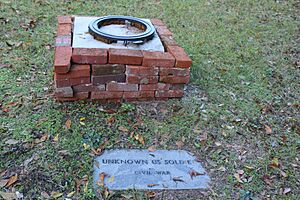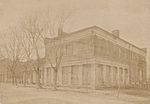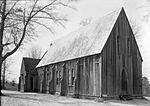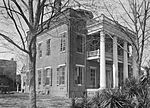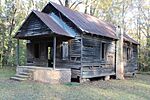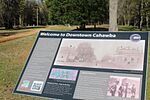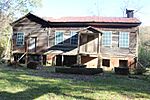Cahaba, Alabama facts for kids
Quick facts for kids |
|
|
Cahaba
|
|
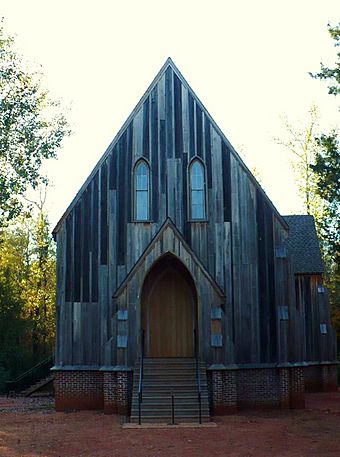
St. Lukes Episcopal Church, built 1854 at Cahaba; moved to Martin's Station in 1878; returned to Old Cahawba in 21st century
|
|
| Nearest city | Selma, Alabama |
|---|---|
| Area | 853 acres (345 ha) |
| Built | 1818 |
| Architect | Multiple |
| NRHP reference No. | 73000341 |
| Added to NRHP | May 8, 1973 |
Cahaba, also known as Cahawba, was once the very first capital city of Alabama, United States. It served as the state capital from 1820 to 1825. This historic town was also the main government center, or county seat, for Dallas County, Alabama until 1866.
Cahaba was built where the Alabama and Cahaba rivers meet. However, this location meant the town often experienced big floods. Because of these floods and other issues, Alabama's leaders decided to move the capital. They chose Tuscaloosa in 1826.
After another huge flood in 1865, the county seat also moved. It went to Selma, which was a safer location. When Cahaba lost its role as the county seat, many businesses and people left. The town quickly became empty.
Today, Cahaba is a ghost town. It is protected as a state historic site called the Old Cahawba Archeological Park. Groups are working to make it a place where visitors can learn all about its past. Even St. Luke's Episcopal Church, a historic building, was brought back to Old Cahawba.
Contents
What's in a Name?
The name Cahaba likely comes from the Choctaw words. Oka means "water" and aba means "above." So, it might mean "water above" or "high water."
Cahaba's Story
Alabama's First Capital
Cahaba started as an empty piece of land where two rivers met. In 1818, a special group chose this spot to be Alabama's new state capital. Since there were no buildings yet, the state's first government met temporarily in Huntsville.
By 1819, the town was planned out with streets named after trees and famous people. A two-story brick building was built to be the new statehouse. By 1820, Cahaba was officially the state capital.
However, Cahaba's location caused problems. It often flooded, and people thought the air was unhealthy. They didn't know then that mosquitoes carried diseases like malaria. These issues led to the capital being moved to Tuscaloosa in 1826. Later, in 1846, the capital moved again to Montgomery.
Before the Civil War
Even after losing the capital, Cahaba grew again. It became an important center for the cotton trade. Wealthy farmers and merchants built large homes. St. Luke's Episcopal Church was built in 1854.
In 1859, a railroad line reached Cahaba, which helped the town grow even more. By 1860, about 2,000 people lived there. Many of the people were African Americans, including both enslaved people and free people of color.
During the Civil War
During the American Civil War, Cahaba played a different role. The Confederate government took over the town's railroad tracks for military use. They also turned a large cotton warehouse into a prison called Castle Morgan. This prison held Union soldiers from 1863 to 1865.
In 1865, a huge flood hit Cahaba. This made life very hard for the soldiers in the prison and for the town's residents. Later that year, two important generals met in Cahaba to talk about exchanging prisoners.
After the Civil War
In 1866, the state government moved the county seat from Cahaba to Selma. This meant that many businesses and people left Cahaba. Over the next ten years, many houses and churches were taken apart and moved to other towns. St. Luke's Episcopal Church, for example, moved in 1878.
Jeremiah Haralson, an African American leader, represented Cahaba and Dallas County in government. He was elected to the State House, State Senate, and even the United States Congress.
By the late 1800s, a former enslaved person bought most of the old town site. He had the remaining buildings torn down. Their materials were shipped by steamboat to help build growing communities like Mobile and Selma. By 1903, most of Cahaba's buildings were gone.
Cahaba Today
Even though no one lives there now, the Alabama Historical Commission takes care of the site. It is called Old Cahawba Archeological Park. It was added to the National Register of Historic Places in 1973.
Visitors can explore the old streets, cemeteries, and ruins of this former capital. A group called the Cahawba Advisory Committee helps support the park. They are also raising money to restore St. Luke's Episcopal Church, which returned to Old Cahawba in the early 2000s.
Ghost Stories of Cahaba
Cahaba, especially after it became a ghost town, has many spooky stories. One famous tale is about a glowing orb, like a ghostly light, in a garden maze. This maze was at the home of C. C. Pegues, which is no longer there. This story was even written down in a book about Alabama ghosts.
Famous People from Cahaba
- George Henry Craig: Born in Cahaba, he later became a U.S. Representative.
- Anderson Crenshaw: An Alabama judge who served when Cahaba was the state capital.
- Jeremiah Haralson: Born in Dallas County, he was an important African American politician during the Reconstruction era.
- Edward Martineau Perine: A merchant and planter who owned a store and a mansion in Cahaba.
Gallery
-
Castle Morgan, a Confederate prison camp on the Alabama River at Cahaba.
See also
 In Spanish: Cahaba para niños
In Spanish: Cahaba para niños
- List of ghost towns in Alabama
- Reportedly haunted locations in Alabama




